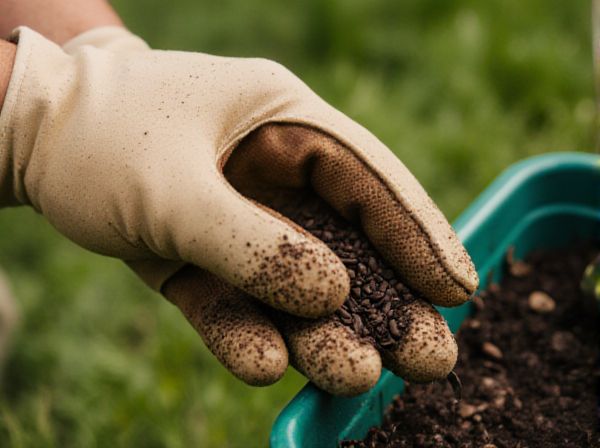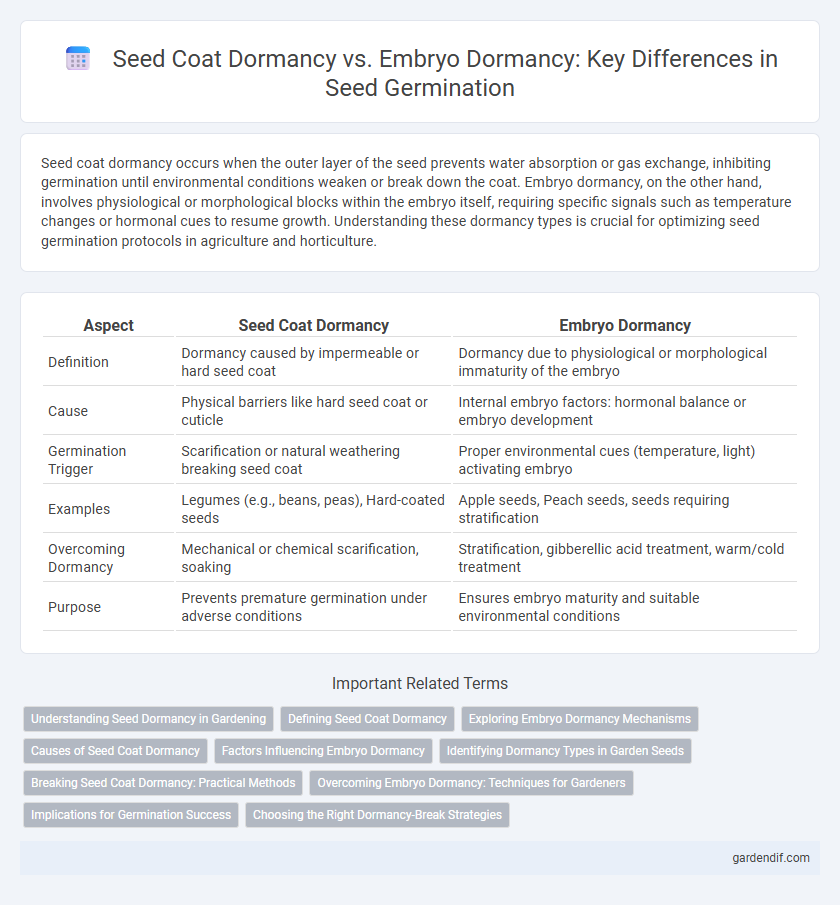
Seed Coat Dormancy vs Embryo Dormancy Illustration
Seed coat dormancy occurs when the outer layer of the seed prevents water absorption or gas exchange, inhibiting germination until environmental conditions weaken or break down the coat. Embryo dormancy, on the other hand, involves physiological or morphological blocks within the embryo itself, requiring specific signals such as temperature changes or hormonal cues to resume growth. Understanding these dormancy types is crucial for optimizing seed germination protocols in agriculture and horticulture.
Table of Comparison
| Aspect | Seed Coat Dormancy | Embryo Dormancy |
|---|---|---|
| Definition | Dormancy caused by impermeable or hard seed coat | Dormancy due to physiological or morphological immaturity of the embryo |
| Cause | Physical barriers like hard seed coat or cuticle | Internal embryo factors: hormonal balance or embryo development |
| Germination Trigger | Scarification or natural weathering breaking seed coat | Proper environmental cues (temperature, light) activating embryo |
| Examples | Legumes (e.g., beans, peas), Hard-coated seeds | Apple seeds, Peach seeds, seeds requiring stratification |
| Overcoming Dormancy | Mechanical or chemical scarification, soaking | Stratification, gibberellic acid treatment, warm/cold treatment |
| Purpose | Prevents premature germination under adverse conditions | Ensures embryo maturity and suitable environmental conditions |
Understanding Seed Dormancy in Gardening
Seed coat dormancy occurs when the seed's outer layer is impermeable or physically tough, preventing water uptake and gas exchange essential for germination. Embryo dormancy involves physiological or biochemical factors within the embryo itself, requiring specific environmental cues such as temperature or light to break dormancy. Understanding these differences helps gardeners apply targeted techniques like scarification for seed coat dormancy or stratification for embryo dormancy to improve germination rates effectively.
Defining Seed Coat Dormancy
Seed coat dormancy occurs when the seed's outer layer, the testa, restricts water uptake or gas exchange, preventing germination despite favorable environmental conditions. This physical barrier can result from impermeable seed coats or chemical inhibitors embedded within the seed coat that inhibit embryo activation. Overcoming seed coat dormancy often requires scarification or environmental factors like temperature fluctuations to break the seed coat's dormancy and enable germination.
Exploring Embryo Dormancy Mechanisms
Embryo dormancy in seeds involves intrinsic physiological blocks that prevent germination despite favorable environmental conditions, primarily regulated by hormonal balances such as abscisic acid (ABA) and gibberellins (GA). Molecular mechanisms include the expression of dormancy-related genes like DOG1, which modulate ABA sensitivity and repress germination-promoting pathways. Understanding these embryo dormancy pathways is critical for improving seed viability and optimizing crop germination strategies in agricultural biotechnology.
Causes of Seed Coat Dormancy
Seed coat dormancy occurs when the outer protective layer of the seed, the testa, is impermeable to water or gases, preventing germination. This dormancy is primarily caused by physical barriers such as lignin and cutin deposits, thickened seed coats, or chemical inhibitors embedded within the seed coat. Environmental factors like temperature fluctuations and mechanical abrasion often break down these barriers, enabling water uptake and subsequent embryo growth.
Factors Influencing Embryo Dormancy
Embryo dormancy is influenced by internal factors such as hormonal balances, particularly high levels of abscisic acid (ABA) that inhibit germination, and genetic controls that regulate growth inhibitors within the embryo. Environmental conditions including temperature fluctuations, light exposure, and moisture availability play crucial roles in breaking embryo dormancy by altering hormone concentrations and activating metabolic pathways. Understanding these factors is essential for optimizing seed germination in agricultural and ecological applications.
Identifying Dormancy Types in Garden Seeds
Identifying dormancy types in garden seeds requires distinguishing between seed coat dormancy and embryo dormancy, as each affects germination differently. Seed coat dormancy occurs when a hard, impermeable seed coat prevents water and oxygen uptake, often overcome by scarification methods such as abrasion or soaking. Embryo dormancy involves physiological or morphological barriers within the embryo itself, which may need stratification or hormone treatments like gibberellic acid to initiate germination.
Breaking Seed Coat Dormancy: Practical Methods
Breaking seed coat dormancy involves overcoming physical barriers to water and gas exchange, essential for initiating germination. Practical methods include scarification techniques such as mechanical abrasion, acid treatment, or thermal shock to weaken or rupture the seed coat. These approaches enhance permeability, promoting embryo hydration and subsequent germination in species with hard seed coats.
Overcoming Embryo Dormancy: Techniques for Gardeners
Overcoming embryo dormancy in seeds involves techniques such as stratification, which mimics natural cold treatment to break physiological barriers within the embryo. Scarification methods, including mechanical or chemical abrasion, enhance water absorption and trigger germination processes by weakening seed coat restrictions. Gardeners often use controlled temperature cycles and moisture regulation to optimize embryo activation and improve seedling emergence rates.
Implications for Germination Success
Seed coat dormancy involves a hard, impermeable outer layer that prevents water and oxygen uptake, directly affecting germination speed and success by requiring physical or chemical scarification for breakthrough. Embryo dormancy, by contrast, is controlled by physiological factors within the embryo itself, necessitating specific environmental cues like temperature or light changes to trigger growth. Understanding these dormancy types guides effective seed treatment protocols to optimize germination rates and improve seedling establishment in agricultural and ecological restoration settings.
Choosing the Right Dormancy-Break Strategies
Selecting the appropriate dormancy-break strategies depends on identifying whether seed coat dormancy or embryo dormancy is inhibiting germination, with seed coat dormancy often requiring scarification techniques such as mechanical abrasion or chemical treatment to penetrate impermeable layers. Embryo dormancy typically demands physiological methods like stratification, involving cold or warm temperature exposure, or application of growth regulators like gibberellic acid to stimulate metabolic activity. Accurate diagnosis of dormancy type through seed morphology and viability tests optimizes germination success and enhances agricultural productivity.
Seed Coat Dormancy vs Embryo Dormancy Infographic

 gardendif.com
gardendif.com